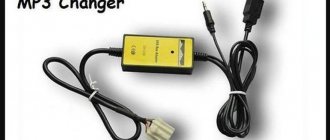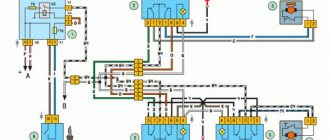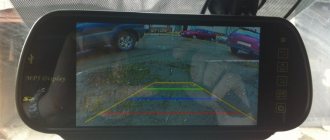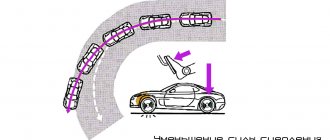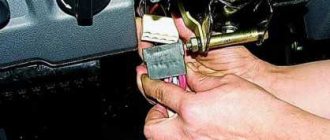Types of subwoofers
Car woofers equipped with a custom housing can have a built-in amplifier or are connected directly to the car radio.
The use of an additional amplifier allows you to relieve the head unit. To perform adjustments across frequency ranges and match the signal with other acoustic devices, a separate crossover is placed. The subwoofer volume is adjusted using a separate rotary potentiometer mounted on the body of the product. The design has a special bass reflex, which provides expansion of the frequency range due to the resonance effect. There are designs of low-frequency devices in which the loudspeaker is placed on a dividing partition inside the housing.
The passive subwoofer is connected through the rear speaker connectors or to special plugs located on the head unit. Such a switching scheme increases the load on the electronics of the radio and negatively affects the operation of the components of the car's acoustic system. But since equipment without an amplifier has a low price, car owners are interested in the question of whether it is possible to connect a subwoofer while minimizing loss of sound quality.
What you will need
How to connect a radio
To install a passive subwoofer without an amplifier on your own you will need:
- speaker cables required for switching;
- plastic buffers to hold the woofer housing in the luggage compartment of the car;
- plastic screwdriver for removing plastic interior trim;
- side cutters for cutting cables;
- plugs needed for connection;
- PVC tape or protective tube;
- flexible clamps;
- protective corrugated tube for laying cables.
Before starting installation work, you should make sure that the purchased equipment is compatible. Connecting speakers with inappropriate coil resistance causes the radio amplifier to overload, which damages the device. If the player has a security code, you need to make sure it is there. Otherwise, after connecting the battery to the on-board network, it will not be possible to restore the radio’s functionality.
Assembly and connection
How to connect a standard and non-standard radio in a car
There are several types of subwoofers, and each of them can be assembled with your own hands, installed yourself, or, of course, you can buy a ready-made one. There is nothing complicated in self-assembly and you can ultimately achieve good results by solving an interesting problem and using extra parts lying around. It is much easier, of course, to buy a ready-made one and connect it without outside help. Connecting yourself will help you save a significant amount. Connecting a subwoofer carries the risk of damaging the interior trim. The car may be damaged. There are no more risks. The wires must be hidden. In general, wires come in different colors, but in any case they will be noticeable.
Selection of cables and wires
Which subwoofer for a car is better, active or passive?
The wires for the speaker system in the car are multi-core cables that transmit sound signals from the head unit or amplifier to the subwoofer. They play no less important role than the equipment itself. However, choosing the right option is not always easy. The cables presented in specialized stores differ in cross-section, core material, insulation and cost.
According to their purpose, cables for car audio come in 2 types:
- acoustic (such products are required to transmit a signal from the amplifier to the speakers);
- interconnect (they are needed to transport low-voltage signals from the radio to the amplifier).
The first piece of advice that professionals recommend following concerns the price category of the product. Thus, a cheap cable for connecting a subwoofer should not be purchased for expensive equipment, since the quality of the reproduced sound will deteriorate. At the same time, buying expensive wires for budget acoustics will be a waste of money.
Depending on the core material, wire sets come in several types:
- Copper. They, in turn, are divided into those made of rough copper and oxygen-free copper (OFC). In the first case, the products are basic and have a relatively low price. The base made of oxygen-free copper allows you to increase the conductivity of the cable, but the cost of the product will be an order of magnitude higher. Another copper wire is PCOCC, in which the base is made of pure copper.
- Copper-plated aluminum. This is another inexpensive wire option. Among the list of disadvantages of such a product, professionals name increased fragility and brittleness.
- Silver plated or silver. Such products for connecting a subwoofer to a receiver have high performance and durability, but are much more expensive.
Operating principle of speaker wire
Speaker wires in cars
As a rule, speaker wires are passive elements of any audio system, and their task is to transmit the sound signal from the source to the speaker. The performance of any cable can be characterized using three indicators:
- Capacity.
- No resistance.
- Inductance.
It should be noted that it is precisely due to such an indicator as the absence of resistance that an ideal signal transmission connection is obtained. When laying an acoustic cable to a subwoofer (see How to make a subwoofer: practical tips), it is important to remember the main rule: “the shorter the length of the wire, the more ideal the output sound.”
Note: this rule does not apply only to professional audio devices where thick cables are used to transmit the sound impulse.
The efficiency of sound signal transmission most often depends on the quality of the conductor. If the resistance of the speaker wire is less than 4-5%, the cable can be used to lay an audio system.
Advice. When choosing an acoustic cable, you need to pay attention not only to price, but also to resistance, cross-section and softness. In this case, you also need to pay attention to the cable core. If it is soft and elastic, then you can safely purchase the cable.
Advantages
Wires for car audio
Speaker wires for a subwoofer should have the following advantages:
- It is easy to bend, but the braid must remain intact.
- When transmitting an audio signal, the sound must be clear: the presence of interference indicates the use of poor-quality material for the conductor.
- Despite strong kinks and temperature changes, the cable must retain its soft properties.
- The speaker cable must be made in accordance with all GOST standards. To convince you, you can check the declared qualities using high voltage.
- A twisted wire made from several strands of copper should not oxidize or rust.
Wires for subwoofer
The positive power wire is laid from the battery terminal and connected through a fuse.
You can draw the negative power wire from any metal bolt that is screwed to the car body. The recommended cross-section for the positive power wire is about six to eight square millimeters. Such a large cable diameter is explained by the high current consumption. Do not forget about the need to use a fuse that will protect the circuit from overload and short circuit. This fuse should be installed under the hood as close to the battery as possible. The second negative power wire, also called the ground wire, is screwed to the body at any convenient point. As a rule, its connection is made directly next to the installed subwoofer. This power wire is connected to the (-) terminal or to the terminal marked GND.
If your standard radio has separate connectors necessary for connecting an active type of subwoofer, then such switching is carried out without any difficulties. From the radio it is necessary to lay a coaxial shielded signal cable, which has corresponding connectors for connecting a subwoofer. On one side, this cable is connected to the radio in the SubOut connector, and in the subwoofer it is connected to the LFE or LineIn connector.
In cases where there is no corresponding output on the radio, you need to use an additional converter that allows you to transform the signal. The converter is connected to the output of the main speaker system.
This will allow us to obtain a linear standard signal at the output of the converter. Subsequently, such a linear signal is supplied to the corresponding subwoofer outputs. The connection is made using the same signal wires as in the first case if there is a subwoofer output.
To ensure the required sound quality, signal and cable products must be selected from professional manufacturers. The choice in specialized stores is extremely wide. We can recommend that you use cables from the following manufacturers - Profigold, Kimber Cable, Ost, Monster Cable. But what we wouldn’t recommend you do is buy a cheap Chinese cable.
It is quite possible that the cost of such a cable will seem attractive to you, but its quality is at a mediocre level, and you will not receive any return from the installed subwoofer. When performing installation work, the following rules must be observed. The cable is laid using the shortest route. Avoid sharp bends in the cable. When passing the cable through metal elements, rubber bushings should be used to protect the cable from chafing by metal.
These installation instructions will allow you to do all the work yourself and will significantly improve the sound quality of the standard stereo system in your car.
Connection diagrams
The process of connecting a subwoofer and speakers in a car rarely causes difficulties. The recommendations described below will help you install and connect correctly.
Passive
It is recommended to connect passive low frequencies through an audio amplifier. It has connectors for connecting a subwoofer. For switching, special acoustic wires are used. They come complete with a subwoofer. If they are not available, then we buy the required length in a specialized store or at the radio market. The ends must have RCA connectors (tulip type).
In the absence of an amplifier, a passive subwoofer is connected to the front speakers. The sound will become more voluminous, but it is difficult to call it quality. A low-pass filter will help correct the situation. Through it, sound is sent to a passive subwoofer. The purpose of the filter is to suppress the high-frequency component of the sound signal and feed only the bass to the subwoofer.
Read more: When accelerating, why does engine detonation occur and how to eliminate it?
The signal from the standard radio goes to the amplifier, and from it is distributed to the speakers and subwoofer
Active
An active subwoofer does not require the use of an amplifier. Its body contains an additional module for sound amplification and frequency controls for fine tuning.
Modern car radios have a linear output for connecting a subwoofer. It is connected to the input of the active subwoofer using an speaker cable. Another wire is designed to control the subwoofer. It is designated as REM or System Remote Control. The cross-section of the control wire is not critical; a weak current flows through it.
The active subwoofer is connected directly to the standard radio.
The power to the subwoofer comes from the car's battery. Separately, a power cable from the battery is laid to power the active subwoofer. Be sure to install a fuse in the power supply circuit of the amplifier and active subwoofer. It protects the speaker system from short circuits.
First, the ability of the car amplifier to operate in bridge mode is checked. If this device is not designed for it, it will quickly fail due to overheating and overload. It is also worth considering that the operating resistance will change. With a bridged connection, audio will only be output from one channel.
To connect the amplifier you will need:
- speaker cables;
- power wires;
- speakers and subwoofer;
- fasteners.
Since the power consumed by the bridge car amplifier from the on-board network will increase several times, the cross-section of the wires used to connect the power supply must be at least 3 mm. This will help avoid sudden muting and distortion of the sound at high volumes.
The thickness of the speaker cables should also not be thin to ensure effective sound transmission through the bridge system.
The fuse rating is selected based on operational reliability. If the burnout of an already installed fuse-link occurs frequently, then the rated current does not correspond to the increased energy consumption of the device.
A fuse with a higher value should be installed. You can also include an additional 30 A fuse in the positive wire gap to increase the protection of a two-channel amplifier connected via a bridge circuit from overload and short circuit.
How to connect a subwoofer to an amplifier
Single channel connection
Connecting a subwoofer to an amplifier is not difficult; just connect the amplifier's audio output jack to the subwoofer coil or coils using speaker wires.
The wires should not be thin. In most cases, choose copper wiring with a cross-section of 4 mm and there will be no problems.
Connecting speaker wires
This subwoofer connection diagram is suitable for one channel of an amplifier or monoblock.
Connecting to a subwoofer via terminal block
Connecting to a subwoofer directly
Connecting a subwoofer with a bridge
In the case of using a multi-channel amplifier, the sub can be connected to two channels simultaneously, using the minus of one and the plus of the other, this connection is called bridged, with this method the power output by the amplifier increases significantly (see the specifications for specific numbers).
So you can connect a subwoofer to a two or four channel amplifier, using 2 channels for acoustics, and the remaining 2 for the subwoofer.
To connect a subwoofer with a bridge, make sure that your amplifier supports this feature.
If you connect a low-frequency speaker to an amplifier by changing the polarity, that is, connect the plus of the subwoofer to the minus of the amplifier output and vice versa, then the speaker will work in antiphase, there is nothing wrong with that, sometimes such a connection is used intentionally if the amplifier does not have phase adjustment (more about adjustment phases).
Connecting the subwoofer coils
The technical documentation for the subwoofer states the resistance of its coils (1 Ohm, 2 Ohm, 4 Ohm, rarely 0.5 Ohm), and the technical documentation for the amplifier indicates what resistance it can work with, this information is needed so that you connect correctly and effectively subwoofer to amplifier. The lower the resistance of the sub, the more power the amplifier will produce, provided that it can operate at this resistance. A subwoofer speaker may have several coils (1 or 2, rarely 4).
When the coils are connected in series, the resistance increases, while in parallel it decreases. If you don't want to learn definitions and count fractions, just save this cheat sheet (parallel and serial connections).
Connection options
How much ohm to connect the subwoofer
The higher the resistance, the better the sound quality; the lower, the more power the amplifier delivers. If you need a lot of loud bass, then turn it to the minimum that the amplifier can provide, and if the overall sound quality of the system comes first, then it is 2 Ohms or 4 Ohms, depending on the power output.
Video on how to connect 2 subwoofers or more. Subwoofer connection diagram 2x2 Ohm, 4x4 Ohm, 1x1 Ohm. Serial connection of speakers. Parallel connection of speakers. Basic principles.
Happy connections!
Connection diagram of the subwoofer to the standard radio
The connection diagram looks elementary:
— GU (wires going to the rear speakers are designated in the diagrams as RR+- and RL+-) — signal converter — external amplifier.
If you use high-level inputs on the amplifier, then it’s even simpler:
- GU - amplifier. On the amplifier, the high level inputs are labeled Hi Level Input, Hi Input, or Speaker Level Input.
MORE Car audio
Pros and cons of a standard car radio
Instructions for connecting the Mystery passive subwoofer to the Pioneer radio
The schematic diagram of low-frequency speakers of both active and passive types is almost the same, with the exception of small additions related to non-active subwoofers.
For this reason, we will analyze the general method and then make changes.
The process of turning on a car radio with a passive subwoofer is very simple: it is connected directly to the amplifier, which, in turn, is connected in series to the car player.
The role of the standard amplifier in this circuit is to transmit the signal received from the sound of the playback device (car radio) to speakers with high and low resolution frequencies. Where the subwoofer itself acts as a converter of low-frequency signals, and its satellites act as a converter of high-frequency signals.
Due to its rather large dimensions, the installation of the subwoofer is carried out mainly in the luggage compartment of the car and the power supply wires have to be pulled through the entire cabin to the battery. Which does not improve its (interior) appearance.
Not active subwoofer
You can connect a passive subwoofer to a radio without an amplifier in 4 steps.
- Through the technological hole in the engine compartment we stretch the supply wire to the battery. We install a fuse on the positive (plus) wire closer to the battery.
- We pull the wiring into the cabin and stretch it to the trunk, if possible disguising it under the interior trim parts.
- We insert the wires through the finished technical hole (if necessary, we make it ourselves) into the trunk of the car. And we connect directly to the low-frequency speaker, according to the diagram (on, to -).
Connecting the subwoofer to the Pioneer radio via a single-core power (blue) wire and a wire with tulip connectors
Step-by-step guide: installation, connecting a passive subwoofer
Now let's look at how to connect a subwoofer to the linear output of the radio:
- Look for technological holes for laying wires. It should be noted that they are not available on all cars, so you will have to refer to the instruction manual.
- Do the wiring under the hood of the car. Try to avoid pinching and kinking. All cladding that will be removed during the work will be installed upon completion.
- Lay the wires to the luggage compartment.
- Observe polarity when connecting power wires to the amplifier.
- Connect the amplifier to the radio. You will need wires with tulip tips. You will also have to lay a wire to control the operation of the amplifier.
- Install the “tulips” in the connectors according to color.
- Now you can connect the amplifier and sub. There are no difficulties here; just insert the plug into the appropriate connector.
The use of a capacitor is recommended, but not required. It is only needed if the total acoustic power is more than 0.4 kW. It can be placed both in the luggage compartment and in the engine compartment.
Where to install
For some motorists, installing acoustic equipment can be a big problem. The matter concerns both the size of the device itself and the car model.
Hatchback and minivan. In cars with this type of body, you can easily find space even to accommodate a large system. This is explained by the good trunk capacity.
Sedans. The trunk in sedans has a smaller volume, so there is not always room there to install a subwoofer. The problem can be solved by installing speakers in the armrests or on the rear shelf.
Cabriolet. In such a body, it is most difficult to connect a subwoofer to the car, since space is at a premium here. In this case, it is better to choose bandpass type acoustics or FC cabinets equipped with a bass reflex.
Connection types
Active subwoofer installation diagram
However, to install a subwoofer in each type of car, a special approach is required.
Sedan
Active subwoofer installation diagram
Installing a subwoofer in such a car is difficult, so you will have to tinker with it. It is best to install low-frequency heads in such a car. So:
- It is better to install them directly on the rear shelf.
Note: Any subwoofer can be installed here. Its design may also be different.
- Subwoofers are also mounted in armrests. You need to pay attention to the holes. They should be quite large, otherwise there is a possibility that the diffuser will remain closed, and because of this the sound will be somewhat distorted.
Hatchback
Speaker in a hatchback
The easiest way to install a subwoofer is in cars of this type. When choosing a subwoofer for this model of car, you must take into account that the most accurate sound is provided by devices with 10-inch heads.
Cabriolet
Where can you install speakers in a convertible?
But installing a subwoofer in a car with a convertible body type is the most difficult. This is primarily due to the fact that there is very little space here, so there is absolutely not enough space for woofers.
Types of subwoofers
DIY subwoofer installation diagram
First, a little about the product itself. A subwoofer is a speaker that produces low-frequency sound (bass). There are two types:
- Passive;
- Active;
Sub in the case
In the first case, the design consists of 1-3 speakers installed in a wooden case. Many people are interested in how to make a passive subwoofer? - very simple. To do this, you only need a pair of low-frequency speakers, for which the housing should be made of wood. The disadvantage of this product is that its power is high and for normal operation it will require the installation of an amplifier. Will the subwoofer work without an amplifier? - of course, this is an ordinary speaker, but its sound will leave the best (you won’t be able to get loud and clear bass with this connection).
subwoofer without housing
Active subwoofers differ in that they already have an integrated amplifier and can be directly connected to the radio.
Some radios may also have amplifiers in their design, which allows you to connect woofers directly, without additional equipment. But before you connect it to a standard radio, you should make sure that the parameters of its amplifier are higher than those of the subwoofer.
And without an amplifier?
Some may wonder, is it possible to connect a subwoofer to a radio without an amplifier? It's possible, but it won't do any good. The sound will begin to distort, since the entire frequency band will be reproduced, rather than a narrow range.
In addition, the tape recorder amplifier may fail, since the head has a very low resistance - 1-2 ohms. For comparison: a regular speaker has 4 or 8 ohms. Therefore, for the output chip this will be equivalent to a short circuit.
How to setup
Correctly setting up the subwoofer allows you to make the most of all the capabilities of the speaker system in your car. Some music lovers still use factory settings, but this can greatly affect the sound quality. This feature is explained by the fact that the manufacturer cannot take into account the preferences of each listener. In addition, the quality of the reproduced sounds is greatly influenced by the type of car body and the installation features of the subwoofer.
Inaccuracies when connecting the subwoofer to the standard radio and setting up the system cause resonance in the car and rattling of individual elements of the plastic trim. To correct the sound, experts suggest using a specialized disc. It can be found in auto stores. This disc contains musical compositions with which you can fine-tune the settings.
Active subwoofer
To properly set up an active subwoofer in a car, you need to go through several stages of work. The stages of work are similar for any type of connection (to a monoblock or through amplifiers).
First of all, turn on the low-pass filter. It can be located on the radio itself or on the amplifier. The filter can be called as follows: Low Pass Filter (abbreviated LPF), as well as LF or low-pass filter. This action is necessary to minimize the sound of mid and high frequencies. When the filter is turned on, only bass will be heard.
Initial volume and frequency settings. Before you properly configure the sub, you need to find the filter frequency control - it is located on the amplifier and marked Frequency. Its indicator should be at around 80 Hz. The sensitivity control can be recognized by the inscription Gain or Level. Its level must correspond to that of other regulators.
Switching polarity. Only the fact in which direction the speaker cone will begin to move depends on the specific connection. In order to adjust the parameter, you need music in which the bass is reproduced clearly and clearly. After this, you need to find a sound option in which the subwoofer will produce sounds that are indistinguishable from the sounds from other elements of the speaker system.
The next task is to adjust the subsonic. This name refers to a subtonal filter that cleans musical compositions from excessively low sounds. In most cases, a level of 20 Hz will be sufficient. Those who prefer the loudest bass possible may need a level of 40 Hz.
It is equally important to configure the subwoofer taking into account mid-bass performance. This again requires volume control and a low-pass filter.
If you need soft bass, set the volume higher and the filter lower.
Passive subwoofer
Some buyers think about adjusting the radio for the subwoofer at the stage of choosing a speaker system. At the same time, there is an opinion that an active subwoofer is simpler and more convenient to operate, install and configure. This is not entirely true.
The advantage of active devices is simple, quick installation. Meanwhile, the absence of a separate amplifier for the subwoofer in the car reduces possible adjustment modifications.
Ready-made factory kits somewhat limit the buyer’s choice. You won’t be able to buy a powerful, high-quality product for relatively low prices. Well-equipped devices require large investments. To purchase an active subwoofer for a car, in some cases you will have to make concessions on certain parameters.
The highest quality and most flexible connection settings are those devices that were made to order. In these cases, you can make a parallel-connected subwoofer and make the most fine-tuning of the radio, subwoofer and other individual components of the system.
Technical characteristics and design features
Speaker wires for cars
Speaker wires for a subwoofer are essentially an acoustic cable that connects the amplifier and the playback device into one. A modern speaker cable consists of two or more conductors, which are separated from each other by insulating material. In most cases, polymer plastic or rubber is used for insulation.
Note. In this case, the conductors in the cable have different colors, so as not to confuse the polarity when connecting the audio system.
As a rule, when choosing speaker wires for a subwoofer, you need to pay special attention to:
- power and compression indicators.
- cable resistance, since this parameter greatly affects the quality of the incoming audio signal.
Note: preference should be given to cables with the highest resistance.
In earlier times, copper was the main material for making cables. In this case, the wire was wrapped in paper, on top of which it was covered with a special non-flammable layer. When producing modern analogues, manufacturers are increasingly using twisted cables designed specifically for acoustics. To give additional strength, paired conductors are soldered together at the ends using a banana connection. Multi-component plastic and non-flammable rubber are used as an insulating coating. To obtain the greatest reliability, it is necessary to calculate the maximum load of the audio system.
CORRECTLY CONNECTING A SUBWOOFER TO AN AMPLIFIER
The subwoofer is connected to the amplifier using a car audio converter (adapter, adapter). This is a small device with a pair of RCA outputs and two pairs of wires, two of which are used to connect a dynamic emitter. The rest of the wires can simply be hidden - they are not needed for now. The line output wires (RCA OUT) must be connected to the amplifier.
The principle of connecting a subwoofer to a single-channel amplifier
To connect a car subwoofer to a mono amplifier, you will need to connect the positive and negative voltage wires from the amplifier to the same terminals of the subwoofer - that's all. Connecting several passive subwoofers is a little more complicated. Their connection is carried out in a parallel or series circuit, but with the obligatory precise calculation of their internal resistance.
The principle of connecting a subwoofer to a two-channel amplifier
In this option, the connection is made using a bridge circuit. This connection technology works great with virtually all two-channel amplifiers, to which you need to add another subwoofer. Here, too, everything is simple - we take the positive wire from one channel, and the negative wire from the 2nd channel and feed it to the corresponding terminals of the subwoofer.
When making this connection, special attention should be paid to the internal resistance of the subwoofer, which should be 4 ohms. In addition, you should take into account that with this option, the output power of both channels is added
If the amplifier has the function of switching mono and stereo modes, then in this case the wires are connected to the positive and negative terminals of one channel. If there is a need to connect two subwoofers to the amplifier, then the speaker cable from them is fed to different channels.
For correct and clear operation of the subwoofer, you should provide an LPF low-pass filter, which will set the upper limit of the low frequency.
The principle of connecting a subwoofer to a four-channel amplifier
The standard connection of a speaker system to a four-channel amplifier is considered to be a scheme with two speakers and one subwoofer.
So, the typical way to connect an audio system to an amplifier would be the option of two speakers and a subwoofer. In this case, the sub is connected to the amplifier via a bridge circuit, and the audio speakers are each connected to their own channel. The peculiarity of this connection is that the speakers must work with the front channels, and the sub with the rear ones. But at the same time, it is possible to connect a pair of subwoofers to different rear channels.
Subtleties of connecting an active subwoofer to a car radio
An active subwoofer is a self-sufficient device equipped with a built-in amplifier. No additional equipment is required to connect it to the car radio. In this case, it is appropriate to use an RCA type interface (unofficially called “tulip”).
Some car radios are not equipped with special outputs for connecting to a subwoofer. In such a radio, you can use standard sockets designed for connecting speakers. In order to ensure normal functioning of the radio with a subwoofer, you need a low-pass filter of 20-250Hz. It allows you not only to achieve optimal sound quality, but also to preserve the amplitude-frequency properties of the equipment.
Before using the subwoofer, a number of adjustments are made. Modern amplifier models are equipped with the option of controlling the limits of high frequencies. This function can prevent poor matching of the amplitude-frequency properties of the sound with mid-range speakers.
Perform all work when connecting any electrical equipment only with the engine turned off.
Back Next
Four main types
The main types of subwoofers are:
- open;
- hull;
- active;
- passive.
An open subwoofer is the first option. It needs to be built into any of the car panels. This is a smart option for anyone who doesn't like to fiddle around for too long. There is a second option - case-based. It will have to be built into a special box. The calculation here must be accurate. This box increases the sound pressure on the speaker. The speakers are 100% engaged. With its help you can slightly adjust the sound.
There is also a distinction between passive and active. Passive is simple. It lacks an amplifier and crossover. It must be connected in parallel with other speakers. You can make a crossover yourself and include it in the system. But it’s easier to immediately install an active subwoofer, which has both an amplifier and a crossover. Connecting an active subwoofer to your car will solve many problems at once.
In addition, a passive subwoofer sometimes causes a quieter sound from the speaker system, which must be taken into account when making a decision. Active will give good volume. An amplifier and crossover simplify the wiring diagram. It is easier to install an active subwoofer with your own hands without experience, although some may disagree with this point of view.
The amplifier and crossover are important elements. Think about the available options, compare them with the final goal, which is drawn in the mind - rationally. If there is no time or desire to choose or think, in the worst case, an extra part may appear in stock, which is also not a disaster. The supplier or seller, alas, is not obliged to accept back the purchased item if there is no receipt, damage appears, and so on. The money spent could have been invested in something else, but you can always sell speakers, microphones, subwoofers to someone who really needs them. This will allow you to return most of the amount.
How to connect a subwoofer to a car radio with your own hands
Car subwoofer
Every car owner wants, while driving, to listen to music that sounds high quality and without interference. After all, the radio itself does not have sufficient sound power. In this regard, car enthusiasts are interested in how to properly connect a subwoofer to a car radio. Our instructions, as well as the video in this article, will give you a comprehensive answer to many questions that arise during the connection process.
Types of subwoofers
Before talking about connecting it yourself, it’s worth understanding what a subwoofer is (see How to make a subwoofer: practical tips). This device is nothing more than a loudspeaker capable of reproducing the lowest frequencies (below 20Hz). As a rule, they do not fall within the range of the radio itself and the amplifier, which only begins at 20Hz. This type of audio equipment is divided into two types.
Passive
One of them is a passive subwoofer. It has one or more speakers combined in one housing. Connect it to an external amplifier, which can simultaneously supply a signal to both the subwoofer and the speaker:
- This is one of the options that some car audio experts consider not entirely successful. The fact is that the subwoofer has a crossover filter that processes the stereo signal coming from the amplifier and removes low frequencies from it.
- Next, the filtered signal is sent to the speaker speakers. Therefore, an additional filter is used to process the high-level signal.
Connecting a passive subwoofer: diagram
- There is another way to connect. In addition to the crossover filter, it provides for the use of a separate amplifier for the subwoofer. In this case, it is possible to separate the bass from the linear signal, and such filtering produces much less sound distortion than the signal processing that occurs with the first connection method.
- Using a separate amplifier for the subwoofer makes it possible to significantly increase the sound range of the speaker system. In this case, the amplifier driving the main speakers is freed from increased loads.
By installing a crossover filter at the desired point in the audio path, this connection scheme turns the subwoofer from passive into active. And the system itself gives the same sound as in the case of a two-channel amplifier.
Active
In the housing of an active subwoofer, in addition to the speakers and crossover filter, there is also an amplifier (see How to connect an amplifier and a subwoofer to a car radio: you are your own master). It has not only an input for connecting to the signal-supplying amplifier, but also outputs for an additional amplifier. So:
- Depending on the modification of the subwoofer, its signal level is adjusted with a special handle. Often the design of an active subwoofer also provides for frequency adjustment after signal separation.
Rear panel of the active subwoofer
- This allows you to select the optimal value for best compatibility with your main speakers. Naturally, the price of such equipment depends on its capabilities. By connecting an active subwoofer to an audio system, you can increase its dynamic range, as well as improve sound clarity at mid frequencies.
- In addition, you will be able to listen to music at high volume, without interference or distortion. The signal filtered from low frequencies allows the speakers to better reproduce compositions with a high sound level.
- It is only important to purchase equipment designed specifically for cars, and not think about how to connect a home subwoofer to a car radio. Using a subwoofer in a car, for example from a home theater, can only worsen the playback quality.
Incorrect subwoofer settings, or simply the use of low-quality audio equipment, lead to the same disastrous consequences.
Making a connection
It's time to talk about how to connect an active subwoofer to a car radio. Naturally, you first need to supply power, which is provided by the battery. It is very important to choose the right speaker cable - the quality of the entire sound system depends on it. So:
- The cable cross-section, first of all, depends on the power of the subwoofer, and is selected according to the table. Ideally, you need to run two cables from the battery: positive and negative. But many people only connect the plus to it, and connect the minus to the car body.
- It is advisable that the power cable be protected with corrugation, and a fuse should be installed in the holder flask next to the battery. In the photo below you see just such a connection.
Power cord and fuse
- By the way, the fuse must have a power of at least 40A, and it must be located in close proximity to the battery terminal. Only after this will it be possible to connect to the radio.
- The easiest way to connect is if the subwoofer output in the car radio is provided by the manufacturer. It is usually labeled "Out". The input for this wire on the subwoofer is designated “In”.
- But this situation, when there is no subwoofer output in the car radio, occurs quite often. In this case, the connection is made through the speaker outputs, using a low-pass filter. This is done so that the subwoofer can only produce the low frequency range. This is important for the quality of the reproduced sound.
Subwoofer output on car radio
- At the peak of low frequencies, the subwoofer operates at maximum power, and a decrease in the brightness of the switched-on devices can be observed on the panel. To save the system from overloads, you need to install a capacitor next to the subwoofer.
- This device condenses excess voltage into itself, releasing it when it drops below the value required for the subwoofer to operate. The same capacitor should be installed next to the amplifier.
- Installing an active subwoofer is less complicated and is more often used by car owners who want to save money. A passive subwoofer is more difficult to install. Not everyone will be able to install it themselves, even after watching the video.
This requires a professional approach, and, as you know, it is not free. But the result is pleasing. Which way to go is up to you. The main thing is that you ultimately enjoy listening to music while inside your car.
Grigory adored cars since childhood, and in his teens, when he independently connected the car radio in his father’s nine, he realized that cars would be his job, hobby, calling. Rate this article: Share with friends!
Connection instructions without amplifier
The location of the subwoofer depends on the car model and the design of the subwoofer. The equipment is placed in the luggage compartment and is kept from moving by stops attached to the floor covering. There are devices located under the front passenger seat. Flush-mounted subwoofers have reduced dimensions, allowing the device to be placed in a narrow cavity under the chair. During installation, it is necessary to take into account the location of the ventilation ducts and electrical cables of the standard seat heating system.
An acoustic double interconnect cable of the RCA standard is laid through the car interior along the standard electrical harnesses. To ensure protection of the cord, a corrugated sleeve is used, which is laid along the thresholds of the car. From above, the highway is covered with carpet floor covering and plastic cladding. At the ends of the cable it is necessary to install connectors intended for connection to the head unit and subwoofer.
A number of radios are equipped with a standard cable harness, which has a round connector for connecting a subwoofer. Since the equipment is connected via 2 plugs, it is necessary to use an additional splitter. The product is placed next to the speaker, an RCA cable is laid through the interior, but only 1 branch is used. The “tulips” at the end of the splitter are connected to the connectors of the low-frequency speaker.
To connect a passive subwoofer to the rear outputs of the radio, you should combine the outputs into a common circuit. Equipment with a power lower than the total output of the channels is connected to the rear speaker outputs. For example, Pioneer head players equipped with a 4-channel amplifier with a power of 50 W per stream allow the use of a woofer of no more than 70 W.
To ensure the functioning of the subwoofer, you must enable the required operating mode through the menu of the head unit. User can select normal or reverse phase mode. After selecting the required parameter, the settings are saved to the radio's memory. When you turn off the power or press the special reset button, the memory is cleared and the setting will need to be repeated again.
The cutoff frequency is separately regulated, which is selected from a range of values. The number of valid options depends on the modification of the player. To ensure rich sound, a high-pass filter is configured, which stops the transmission of the corresponding sounds through the standard front and rear speakers. Head units use a parameter for additional bass boost; the value is selected from a step range.
Since direct connection does not provide high quality sound reproduction, it is recommended to connect low-frequency speakers through an additional amplifier. The equipment is connected to the head unit with an additional signal cable, through which a switching pulse is sent. To power the amplifier, it is necessary to lay a separate line to the battery, providing it with a fuse installed in a special housing. It is prohibited to connect the amplifier to the side lighting or interior lighting circuits.

